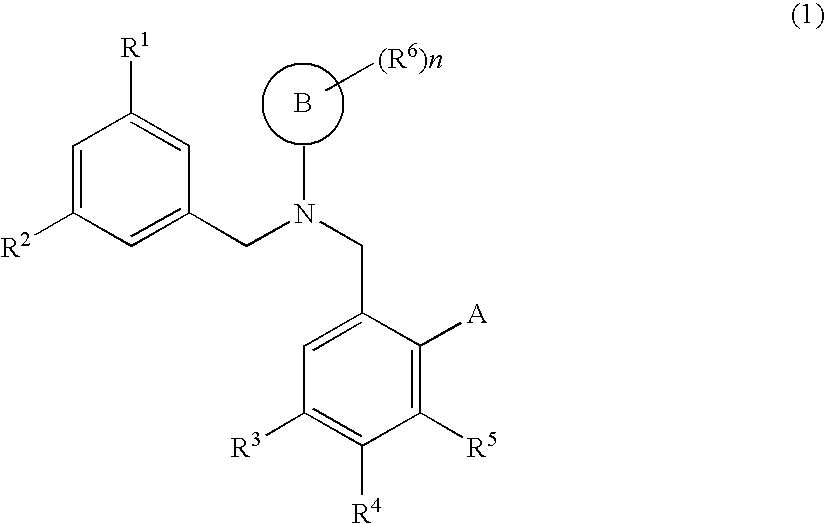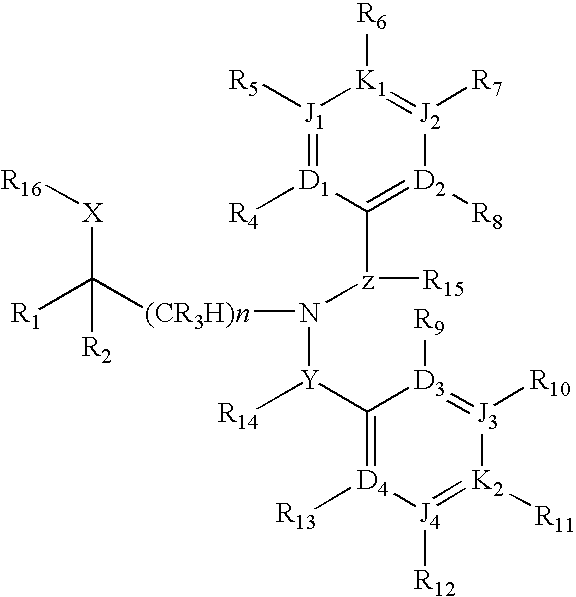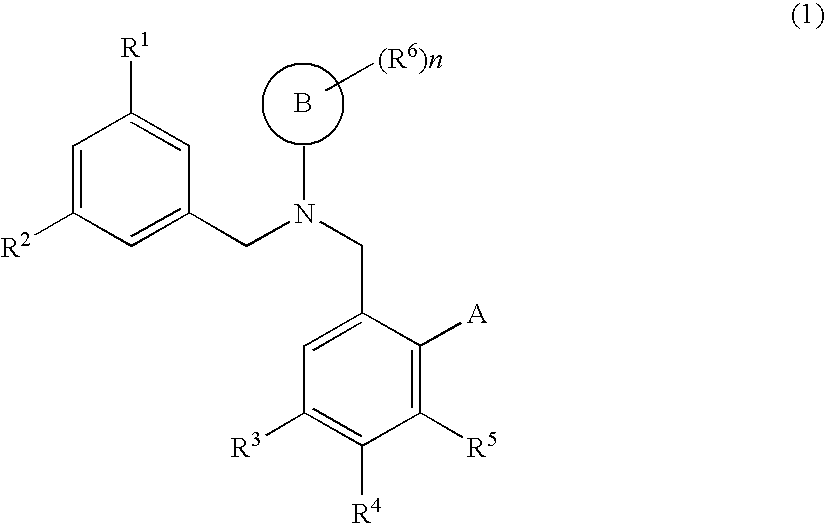Dibenzylamine compound and medicinal use thereof
a dibenzylamine and compound technology, applied in the field of new cetp activity inhibitors, can solve the problems of large hdl dwell in the blood, difficult arteriosclerosis development, and insufficient mechanism function, so as to inhibit the activity of cetp, increase hdl cholesterol, and reduce ldl cholesterol and triglyceride
- Summary
- Abstract
- Description
- Claims
- Application Information
AI Technical Summary
Benefits of technology
Problems solved by technology
Method used
Image
Examples
example 1
N-[3-(N′-cyclopentylmethyl-N′-ethylamino)-5,6,7,8-tetrahydronaphthalen-2-ylmethyl]-N-[3,5-bis(trifluoromethyl)benzyl]-(2-methyl-2H-tetrazol-5-yl)amine
[0538]a) N-[3-(N′-cyclopentylmethyl-N′-ethylamino)-5,6,7,8-tetrahydronaphthalen-2-ylmethyl]-(2-methyl-2H-tetrazol-5-yl)amine
[0539]To a solution (10 ml) of 3-(N-cyclopentylmethyl-N-ethylamino)-5,6,7,8-tetrahydronaphthalene-2-carbaldehyde (333 mg) and 5-amino-2-methyltetrazole (231 mg) in chloroform was added sodium triacetoxyborohydride (745 mg) with stirring at room temperature, and acetic acid (13 μl) was added successively. The reaction solution was stirred overnight and sodium borohydride (50 mg) and methanol (3 ml) were added. The mixture was further stirred for 2 hr. The reaction solution was washed successively with saturated aqueous sodium hydrogen carbonate, water and saturated brine, and the organic layer was dried over sodium sulfate. Sodium sulfate was filtered off and the filtrate was concentrated. The obtained residue was ...
example 2
3-{[N-[3-(N′-cyclopentylmethyl-N′-ethylamino)-5,6,7,8-tetrahydronaphthalen-2-ylmethyl]-N-(2-methyl-2H-tetrazol-5-yl)amino]methyl}-5-trifluoromethylbenzonitrile
[0543]a) 3-bromomethyl-5-trifluoromethylbenzonitrile
[0544]To a solution (10 ml) of 3-hydroxymethyl-5-trifluoromethylbenzonitrile (1.00 g) and carbon tetrabromide (1.81 g) in dichloromethane was added triphenylphosphine (1.37 g) with stirring under ice-cooling, and the mixture was continuously stirred for 30 min. The reaction solution was concentrated and the obtained residue was purified by column chromatography (n-hexane:ethyl acetate=9:1) to give the title compound (1.11 g, 84%).
[0545]1HNMR(CDCl3, 400 MHz)δ: 4.50(s, 2H), 7.85(s, 1H), 7.87(s, 2H)[0546]b) 3-{[N-[3-(N′-cyclopentylmethyl-N′-ethylamino)-5,6,7,8-tetrahydronaphthalen-2-ylmethyl]-N-(2-methyl-2H-tetrazol-5-yl)amino]methyl}-5-trifluoromethylbenzonitrile
[0547]To a solution (2 ml) of N-[3-(N′-cyclopentylmethyl-N′-ethylamino)-5,6,7,8-tetrahydronaphthalen-2-ylmethyl]-(2-m...
example 3
N-[3,5-bis(trifluoromethyl)benzyl]-N-[6-(N′-cyclopentylmethyl-N′-ethylamino)indan-5-ylmethyl]-(2-methyl-2H-tetrazol-5-yl)amine
[0549]In a similar manner as in Example 1, the title compound was obtained (see Table 1).
PUM
 Login to View More
Login to View More Abstract
Description
Claims
Application Information
 Login to View More
Login to View More - R&D
- Intellectual Property
- Life Sciences
- Materials
- Tech Scout
- Unparalleled Data Quality
- Higher Quality Content
- 60% Fewer Hallucinations
Browse by: Latest US Patents, China's latest patents, Technical Efficacy Thesaurus, Application Domain, Technology Topic, Popular Technical Reports.
© 2025 PatSnap. All rights reserved.Legal|Privacy policy|Modern Slavery Act Transparency Statement|Sitemap|About US| Contact US: help@patsnap.com



